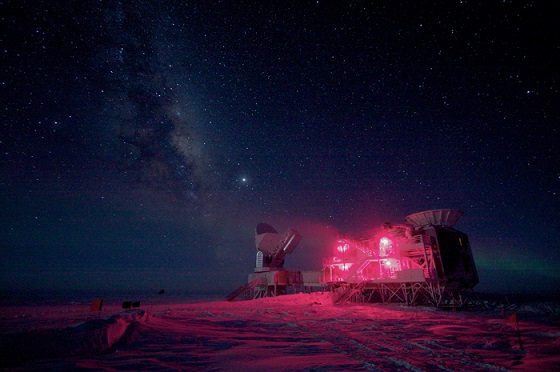این شناسایی با کمک تلسکوپ بایسپ۲(BICEP2) –
تصویربرداری پس زمینه قطبیت فراکهکشانی کیهان- در
قطب جنوب انجام شد. این محققان با همکاری
دانشمندان دانشگاه مینهسوتا، دانشگاه استنفورد،
موسسه فناوری کالیفرنیا و آزمایشگاه پیشرانش جت
ناسا پس از هفتهها کار که از رسانهای شدن آن
جلوگیری میکردند، هفته گذشته نتایج خود را در
مجله Physical Review Letters منتشر کردند. آنها
در چکیدهای اظهار کرده بودند که مدلشان هنوز
سوالات بزرگی را بیپاسخ نگهداشته است. به گفته
محققان، آنها غبار درون کهکشان راه شیری را که
ممکن است خوانشهای آنها را بیفایده نشان دهد،
حساب نکرده بودند. دو تحلیل مستقل اکنون نشان
میدهد که الگوهای در حال چرخش در قطبیت تابش
زمینه کیهانی ممکن است فقط غبار باشد.
اکنون دانشمندان به این نتیجه رسیدهاند که
دادههای کافی برای رد نظریه غبار وجود ندارد.
دانشمندان ابتدا با مشاهده زمینه ریزموج کیهانی یا
درخشش ضعیف به جای مانده از بیگ بنگ، اظهار کردند
که نوسانات کوچک به آنها سرنخهایی در مورد شرایط
جهان اولیه ارائه کرده است. به ادعای آنها، امواج
گرانشی درست لحظه ای پس از بیگ بنگ در سراسر جهان
به گردش درآمده بودند که در نهایت تلسکوپ بایسپ۲
موفق به کشف آنها شده بود. در هفتههای پس از این
ادعا، شماری از دانشمندان تردیدهایی را در مورد
یافتههای تیم بایسپ۲ اعلام کردند.
به گفته آلبرت اینشتین، زمانی که انفجار بزرگی
مانند بیگ بنگ رخ میدهد، ریزموجهایی را در
فضا-زمان بجا میگذارد که به امواج گرانشی معروف
هستند. اولین امواج گرانشی میتوانند به نمایش
اطلاعاتی در مورد تولد جهان بپردازد. دانشمندان
دریافتهاند که این موجها در زمان حرکت در فضا از
خود نشانههایی را در تابش زمینه کیهانی بجا
میگذارند. نظریه اینشتین نشان میدهد که این جهش
اولیه ممکن است جهان نوزاد را از چیزی بینهایت
کوچک به یک چیز به اندازه یک تیله تبدیل کرده
باشد. محققان مرکز فیزیک نجومی هاروارد اسمیتسونین
به ساخت آشکارسازهای تابش فوق حساس پرداخته و آنها
را در تلسکوپ رادیویی بایسپ۲ در قطب جنوب برای
شناسایی این ریزموجها قرار دادند. آنها سه سال به
اسکن حدود دو درصد آسمان پرداختند و پس از ۹ سال
این الگوهای چرخان را در تابش زمینه کیهانی ایجاد
شده شناسایی کردند که توسط امواج گرانشی بوجود
آمده در ابتدای جهان ایجاد شده بودند.
بسیاری از دانشمندان اکنون بر این باورند که یک
رشد ناگهانی ابتدایی و بسیار سریع رخ داده است اما
کشف این شواهد یک هدف کلیدی در پژوهش جهان بوده
است. این کشف به ارائه دریچه رو به جهان در ساعات
اولیه تولد آن پرداخته که بسیار کمتر از یک
تریلیونیوم ثانیه عمر داشته است. اگرچه این کار
باید توسط دانشمندان دیگر بازبینی شود اما هنوز
امکان اهدای جایزه نوبل به آن وجود دارد.
Astrophysicists are casting doubt on what
just recently was deemed a breakthrough in
confirming how the universe was born: the
observation of gravitational waves that
apparently rippled through space right after
the Big
Bang. If proven to be correctly
identified, these waves -- predicted in
Albert Einstein's theory of relativity --
would confirm the rapid and violent growth
spurt of the universe in the first fraction
of a second marking its existence, 13.8
billion years ago.
The
apparent first direct evidence of such
so-called cosmic inflation -- a theory that
the universe expanded by 100 trillion
trillion times in barely the blink of an eye
-- made with the help of a telescope called BICEP2,
stationed at the South Pole, was announced
in March by experts at theHarvard-Smithsonian
Center for Astrophysics. The telescope
targeted a specific area known as the
"Southern Hole" outside the galaxy where
there is little dust or extra galactic
material to interfere with what humans could
see.
"Detecting this signal is one of the most
important goals in cosmology today," John
Kovac, leader of the BICEP2 collaboration at
the Harvard-Smithsonian Center for
Astrophysics, said at the time. By observing
the cosmic microwave background, or a faint
glow left over from the Big Bang, the
scientists said small fluctuations gave them
new clues about the conditions in the early
universe.
The gravitational waves rippled through the
universe 380,000 years after the Big Bang,
and these images were captured by the
telescope, they claimed. If confirmed by
other experts, some said the work could be a
contender for the Nobel Prize.
But not everyone is convinced of the
findings, with skepticism surfacing recently
on blogs and scientific US journals such as
Science and New Scientist.
Paul Steinhardt, director of Princeton
University's Center
for Theoretical Science, addressed the issue
in the prestigious British journal Nature in
early June. "Serious flaws in the analysis
have been revealed that transform the sure
detection into no detection," Steinhardt
wrote, citing an independent analysis of the
BICEP2 findings.
That analysis was carried out by David
Spergel, a theoretical astrophysicist
who is also at Princeton. Spergel queried
whether what the BICEP2 telescope picked up
really came from the first moments of the
universe's existence. "What I think, it is
not certain whether polarized emissions come
from galactic dust or from the early
universe," he told AFP.
"We know that galactic dust emits polarized
radiations, we see that in many areas of the
sky, and what we pointed out in our paper is
that pattern they have seen is just as
consistent with the galactic dust radiations
as with gravitational waves."
When using just one frequency, as these
scientists did, it is impossible to
distinguish between gravitational waves and
galactic emissions, Spergel added.
The question will likely be settled in the
coming months when another, competing group,
working with the European Space Agency's Planck
telescope, publishes its results. The
Planck telescope observes a large part of
the sky -- versus the BICEP2's two percent
-- and carries out measurements in six
frequencies, according to Spergel.
"They should revise their claim," he said of
the BICEP2 team. "I think in retrospect,
they should have been more careful about
making a big announcement." He went on to
say that, contrary to normal procedure,
there was no external check of the data
before it was made public.
Philipp Mertsch of the Kavli
Institute for Particle Astrophysics and
Cosmology at
Stanford University said data from Planck
and another team should be able to "shed
more light on whether it is primordial
gravitational waves or dust in the Milky
Way. Let me stress, however, that what is
leaving me (and many of my colleagues)
unsatisfied with the state of affairs: If it
is polarized dust emission, where is it
coming from?" he said in an email to AFP.
Kovac, an associate professor of astronomy
and physics at Harvard, declined to respond
to requests for comment. Another member of
the team, Jamie Bock of the California
Institute of Technology, also declined to be
interviewed. At the time of their
announcement in March, the scientists said
they spent three years analyzing their data
to rule out any errors.




